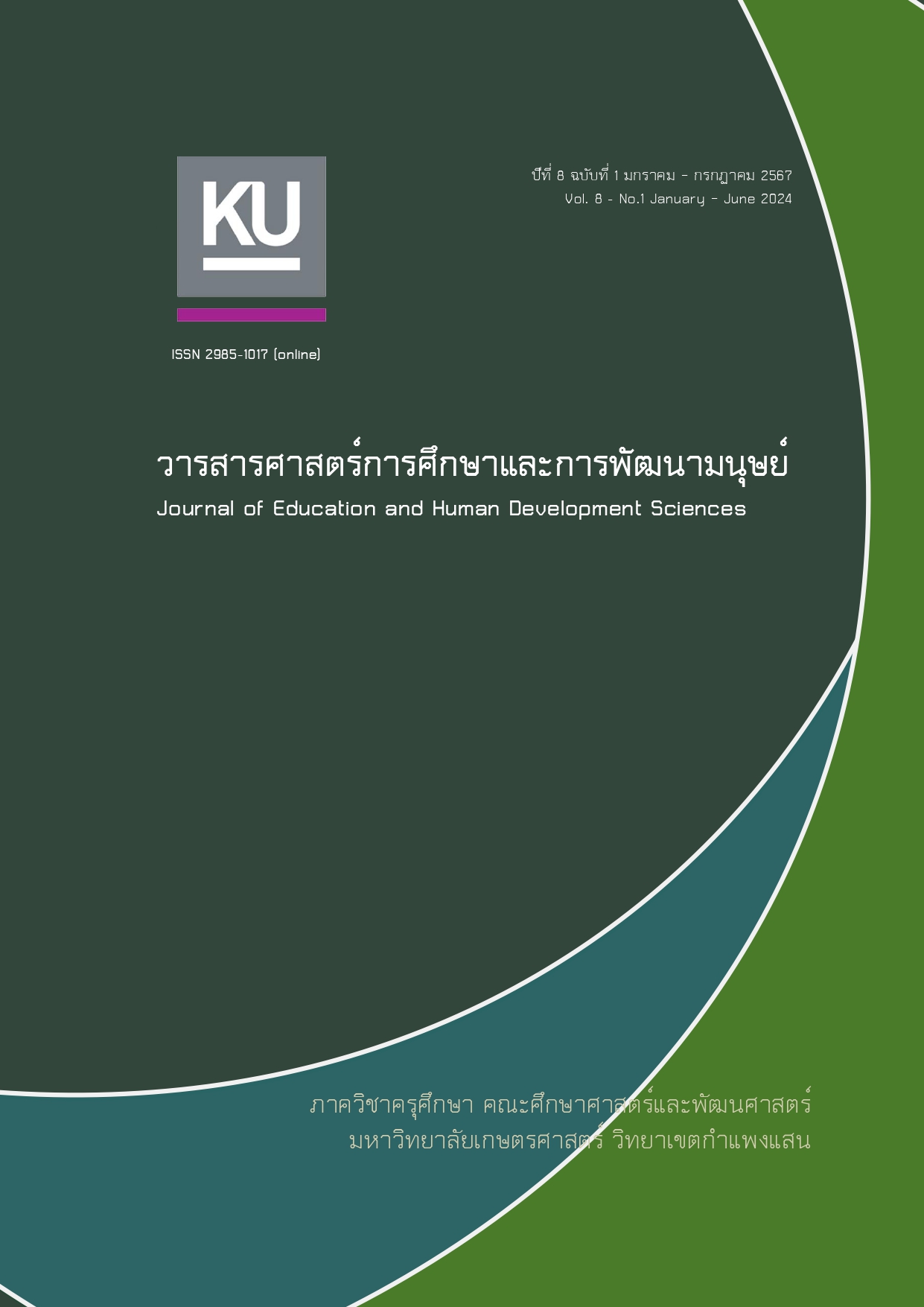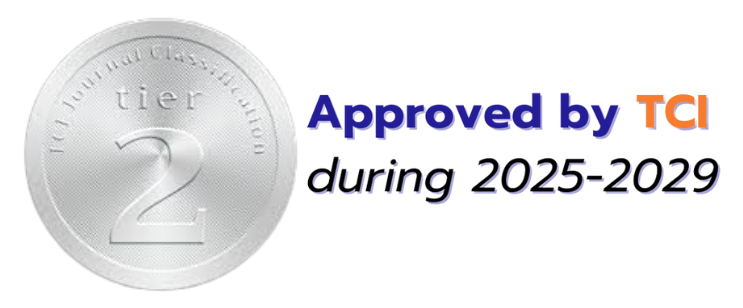การพัฒนาสมรรถนะการจัดการเรียนรู้ของนิสิตครู ด้วยการจัดการเรียนรู้ โดยใช้การออกแบบเป็นฐาน
คำสำคัญ:
การจัดการเรียนรู้โดยใช้การออกแบบเป็นฐาน, สมรรถนะการจัดการเรียนรู้, นิสิตครูบทคัดย่อ
การวิจัยครั้งนี้มีวัตถุประสงค์ 1) เพื่อเปรียบเทียบความรู้เรื่องการจัดการเรียนรู้ก่อนและหลังเรียนด้วยกระบวนการจัดการเรียนรู้โดยใช้การออกแบบเป็นฐาน 2) เพื่อศึกษาสมรรถนะการจัดการเรียนรู้ของนิสิตครูหลังกระบวนการจัดการเรียนรู้โดยใช้การออกแบบเป็นฐาน และ 3) เพื่อศึกษาความพึงพอใจของนิสิตต่อการจัดการเรียนรู้โดยใช้การออกแบบเป็นฐาน โดยมีกลุ่มตัวอย่างในการวิจัย คือ นิสิตครูของคณะศึกษาศาสตร์และ พัฒนศาสตร์ ในหลักสูตรศึกษาศาสตรบัณฑิต ชั้นปีที่ 1-3 สาขาวิชาการจัดการเรียนรู้ที่สมัครเข้าร่วมใน โครงการนิสิตจิตอาสาจัดการเรียนรู้ในโรงเรียนเครือข่าย จำนวน 41 คน ซึ่งได้จากการสุ่มแบบอาสาสมัคร เครื่องมือที่ใช้ในการวิจัยประกอบด้วย 1) แผนการจัดการเรียนรู้ตามกระบวนการจัดการเรียนรู้โดยใช้การออกแบบเป็นฐาน 2) แบบทดสอบวัดความรู้เรื่องการจัดการเรียนรู้ 3) แบบประเมินสมรรถนะการจัดการเรียนรู้ 4) แบบสอบถามความพึงพอใจของนิสิตต่อการจัดการเรียนรู้โดยใช้การออกแบบเป็นฐาน สถิติที่ใช้ในการวิเคราะห์ข้อมูลค่าเฉลี่ย ส่วนเบี่ยงเบนมาตรฐาน และ t-test ผลการวิจัยพบว่า 1) ความรู้เรื่องการจัดการเรียนรู้ด้วยกระบวนการจัดการเรียนรู้โดยใช้การออกแบบเป็นฐานหลังเรียน (= 22.71, S.D. = 3.54) สูงกว่าก่อนเรียน (= 16.05, S.D. = 4.69) อย่างมีนัยสำคัญทางสถิติที่ระดับ .05 2) สมรรถนะการจัดการเรียนรู้ของนิสิตครูหลังกระบวนการจัดการเรียนรู้โดยใช้การออกแบบเป็นฐานอยู่ในระดับปานกลาง (= 3.18, S.D. = 0.89) 3) ความพึงพอใจของนิสิตต่อการจัดการเรียนรู้โดยใช้การออกแบบเป็นฐานในภาพรวมอยู่ในระดับมากที่สุด (= 4.68, S.D. = 0.47)
Downloads
เอกสารอ้างอิง
Arrausi, J. J. (2020). Understanding Design-based Learning (DBL) for teaching Z-Gen learners as Design Education in the 21st Century. Teachingdesigners.org. https://www.teachingdesigners. org/design-education-in-the-21st-century/
Azizan, S. A. & Shamsi, N. A. (2022). Design-Based Learning as a Pedagogical Approach in an Online Learning Environment for Science Undergraduate Students. Frontiers in Education, 7, 1-7. https://doi.org/10.3389/feduc.2022.860097/
Chalargse, N. (2015). The Teacher's Role and Instruction in The 21st Century. FEU Academic Review. 9(1), 64-71. https://so01.tci-thaijo.org/index.php/FEU/index [tranlated]
Chanloy, S., & Satiman, A. (2021). A Development ofthe Blended Instructional Model Using Design Based Learning with SCAMPER Technique to Enhance Creative Educational Innovation
Design Ability of Pre-service Teachers at Rajabhat Universities [Doctoral dissertation, Silpakorn University]. [translated]
Chumnijarakij, T. (1983). Consideration of sample size and sample selection techniques in medical research, Part 1. Chulalongkorn Medical Journal, 27(6), 279-301. https://digital.car.chula.ac.th/ clmjournal/vol27/iss5/1 [translated]
Churches, A. (2008). 21st Century Pedagogy. Edublogs.org. https://edorigami.edublogs.org/2008/08/16 /21st-century-pedagogy/.
Jaquith, A. (2013). Instructional Capacity How to build it right. Stanford.edu. https://edpolicy.stanford. edu/sites/default/files/publications/instructionalcapacity.pdf.
Konglok, S. A. (2020). The Development of Mathematics Teachers Competency on Learning Management by Using the Lesson Study of Elementary Schools in Nonthaburi Province. STOU Education Journal, 13(1), 175-190. https://edu.stou.ac.th/wp-content/uploads/2022/07/9การพัฒนาสมรรถนะการจัดการเรียนรู้.pdf [translated]
Koo, T. K. & Li, M. Y. (2016). A Guideline of Selecting and Reporting Intraclass Correlation Coefficients for Reliability Research. J Chiropr Med, 15(2),155-163. https://doi.org/ 10.1016/j.jcm.2016.02. 012
Lertcharoenri, T., Pimthong, P., Kityakarn, S., Munprom, R., & Ugsonkid, S. (2020). The 12th Grade students’ STEM understanding in the topic of PM 2.5. Kasetsart Educational Review, 35(3), 176-188. https://so04.tci-thaijo.org/index.php/eduku/article/view/244158/168808 [translated]
Management Study Guide. (2022). Competency Ice-Berg Model - Meaning and its Components. Manage mentstudyguide.com. https://www.managementstudyguide.com/competency-iceberg model.htm.
Niraphan, M. (2011). Educational Research Methodology. Silpakorn University Press. [translated]
Office of the Civil Service Commission. (2005). Thai's Civil Service Competency Manual. P.A. Living Co., Ltd. [translated]
Panich, W. (2012). Constructing the way of students' learning in the 21st Century. Sodsri-Saritwong Foundation. [tranlated]
Phrakhrusutaworathammakit & Phramaha Pongtaratid Sutheero. (2020). Development of Thai Teachers to 21st Century. Journal of Graduate Saket Review, 5(2), 19-30. https://so03.tcithaijo.org/index.php/saketreview/article/download/248930/168309/885172 [tranlated]
Rötkönen, E., Winschiers-Theophilus, H., Goagoses, N., Zaman, T., Itenge, H., Tan, D. Y. W. & Sutinen, E. (2022). Creating Smart Connected Learning Ecosystems: A Hybrid Model for
Design-Based Learning. Interaction Design and Architecture(s), 52, 81-100. https://doi.org/10.55612/s-5002-052-005
Sariya, K. (2014). A Development of Assessment Framework of Competencies for Student Teachers’ Learning management and Specific Content Knowledge in the Field of Technology and Innovation Education [Buriram Rajabhat University]. [translated]
Sirapanuwat, N., & Satiman, A. (2021). The Development of a Blended Instructional Model Using Augmented Reality and Innovative Design Based Learning to Enhance Abilities in Creative Jewely Design of Undergraduate Students [Doctoral dissertation, Silpakorn University]. [translated]
Teachers Council of Thailand Regulations on Professional Standards (Issue 4) B.E. 2562. (2019, 20 March). Royal Thai Government Gazette. Rule Number 136, Section Number 68 ngor, p.18-21. [translated]
The Teachers' council of Thailand. (2021). Criteria, methods, and tools for testing and evaluating teachers' professional competencies. Aspects of work and conduct According to the teaching professional standards B.E. 2021. Ksp.or.th. https://www.ksp.or.th/ksp2018/2021/12/34545/ [translated]
Traimongkolkul, P., & Chattraporn, S. (2012). Research Design. Kasetsart University Press. [translated]
Vangmeejongmee, C., & Naiyapat, O. (2017). Competency of Thai Teacher in 21st Century: Wind of Change. Journal of HR Intelligence, 12(2), 47-63. http://www.journalhri.com/artical/article_ 1202_3.html [translated]
Wallerstein, H. A. (1971). Dictionary of Psychology. Penguin Books, Inc.
Weng, C., Chen, C. & Ai, X. (2023). A pedagogical study on promoting students’ deep learning through design‑based learning. International Journal of Technology and Design Education, 33, 1653–1674. https://doi.org/10.1007/s10798-022-09789-4.
Wolman, B. B. (1973). Dictionary of Behavioral Science. Litton Educational.
Worakitkasemsakul, S. (2011). Research Methodology in Behavioral Sciences And social sciences Research Methodology in Behavioral Sciences And social sciences. Aksornsil printing. [translated]
Zhang, F. (2021). Emotions in Design-Based Learning [Doctoral dissertation, Eindhoven University of Technology].
Zhang, F., Peeters, L., Markopoulos, P., Biekens, P., & Bekker, T. (2020). Emotion Awareness in Design-Based Learning. Researchgate.net. 2020 IEEE Frontiers in Education Conference (FIE), Uppsala, Sweden, 2020, pp. 1-8. https://doi.org/10.1109/FIE44824.2020.9273917
ดาวน์โหลด
เผยแพร่แล้ว
ฉบับ
บท
การอนุญาต
ลิขสิทธิ์ (c) 2024 วารสารศาสตร์การศึกษาและการพัฒนามนุษย์

This work is licensed under a Creative Commons Attribution-NonCommercial-NoDerivatives 4.0 International License.







